Tough Ground Covers
These tough and decorative ground covers will fill your garden gaps with style

Every spring, crews spread thick piles of mulch around scattered shrubs, trees, and perennials. I think this practice creates landscapes bleaker than the Mojave Desert. I am not antimulch; on the contrary, I feel that organic, nutrient-balanced mulch is one key to a healthy and maintainable garden. I just don’t like to see it so exposed. A garden in which every square inch of ground is filled with plants is far more appealing than one dominated by chipped wood.
Ground covers have come to be unfairly typified by a few lackluster varieties, such as pachysandra (Pachysandra terminalis, USDA Hardiness Zones 4–8) and green lilyturf (Liriope spicata, Zones 6–10). These plants are certainly functional, but the same can be said for Astroturf. Here are a variety of ground covers that add interest to gardens while suppressing weeds more effectively than mulch alone.
A whimsical cover that American ladies love

Pink running pussy-toes
Antennaria dioica ‘Rubra’
Zones: 5 to 9
Size: 4 inches tall and up to 20 inches wide
Conditions: Full sun to partial shade; sandy, acidic soil
Spacing: 8 to 10 inches apart for coverage in two seasons
If you like flowers and cats—or maybe just cute and resilient plants—you will love pink running pussy-toes. There are a number of Antennaria species, but this is one of the most common in nurseries. This little creeper bears 1-inch-tall, gray-green semievergreen foliage rosettes and 6-inch-tall stalks topped with clusters of light pink flower buds, which bear a slight resemblance to the pads beneath feline paws. Pussy-toes are a favorite of American lady butterfly caterpillars, so while the plants may look a bit chewed on for a few weeks, you will soon be rewarded with a flutter of pretty orange-and-brown butterflies.
This toughest of ground covers can tackle the poorest of soils
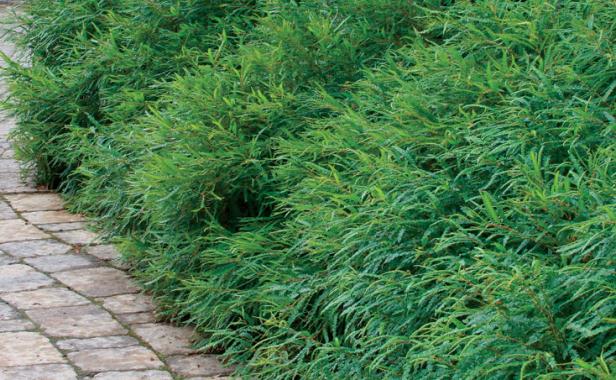
Sweet fern
Comptonia peregrina
Zones: 2 to 8
Size: 2 to 3 feet tall and wide
Conditions: Full sun to partial shade; poor to moderately fertile, moist yet well-drained soil
Spacing: 3 feet apart for coverage in two seasons
Sweet fern partners with special bacteria that convert gaseous nitrogen into ammonia, which the plant uses as fertilizer. This is a tremendous advantage that helps sweet fern thrive in hot, dry, nutrient-poor soils, which few other plants can tolerate. Couple this with salt, wind, and cold tolerance and you have a supremely tough ground cover for places like parking-lot islands and steep, inhospitable banks. Sweet fern neither is a fern nor is it sweet, but it does release a spicy scent when its jagged deciduous leaves are crushed. If it gets too tall, this shrub can be clipped to size or even mown once in late winter.
A little bellwort that needs only a little bit of sun

Sessile-leaf bellwort
Uvularia sessilifolia and cvs.
Zones: 4 to 9
Size: 8 inches tall and 1 foot wide
Conditions: Partial to full shade; moist soil
Spacing: 1 foot apart for coverage in two seasons
This plant is no stranger to North American woodlands. Sessile-leaf bellwort grows sparsely in deep shade, but in a bit of dappled light or even partial sun, it grows with abandon. Six-inch-tall stems rise from spreading rhizomes and dangle pale yellow flowers as trees begin to leaf out. En masse, the effect is a grand yet delicate orchestration. There are several variegated cultivars available that are pretty in an understated way. If you plant this wildflower in moist soil, it will spread quickly.
Plant a blooming carpet of cabernet

Winecups
Callirhoe involucrata
Zones: 4 to 9
Size: 1 foot tall and wide
Conditions: Full sun; sandy, well-drained soil
Spacing: 3 feet apart for coverage in two seasons
Winecups is a heat- and drought-tolerant native wildflower related to hibiscus (Hibiscus spp. and cvs., Zones 5–11), which is why its upward-facing, satiny magenta blooms look like miniature hibiscus flowers. These blossoms perch above deeply dissected leaves that resemble those of a hardy geranium and trail across the ground on low stems. Winecups blooms for a month or so in early summer. In fall, the stems wither to a carrotlike taproot from which growth begins anew the following spring. Seedlings will likely appear the second year and are easily identified by their intricately cut leaves.
This textural beauty is edible too
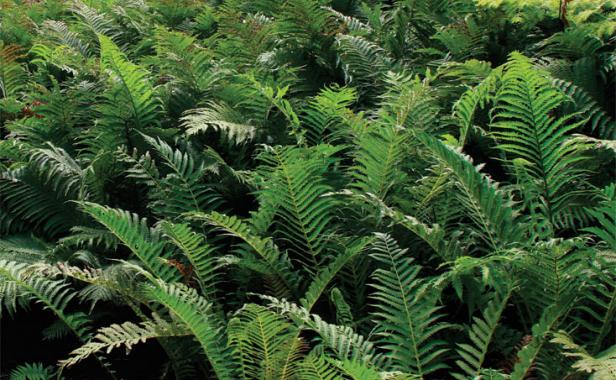
Ostrich fern
Matteuccia struthiopteris and cvs.
Zones: 2 to 8
Size: 5½ feet tall and 3 feet wide
Conditions: Partial to full shade; moist yet well-drained soil
Spacing: 3 feet apart for coverage in three seasons
To conquer a large shaded area, consider ostrich fern. This tall native plant is not a ground cover in the traditional sense, but its size and vigor make it perfect for filling in between trees and tall shrubs. The source of edible fiddleheads, this species sends up plumelike fronds from knobby crowns; in summer, they sprout shallow rhizomes that grow out a foot or two and then form additional crowns. One fern, thus, quickly begets three, and pretty soon, you’ll have enough to start your own fiddlehead business.
Specimen plant and ground cover? You bet

Shredded umbrella plant
Syneilesis aconitifolia
Zones: 3 to 8
Size: 18 inches tall and up to 2 feet wide
Conditions: Half-day sun to light shade; moist, fertile soil
Spacing: 16 inches apart for coverage in two seasons
Flowers play second fiddle to shredded umbrella plant’s highly textural leaves, which look wonderful rising above other ground covers. In early spring, foliage resembling folded umbrellas covered in white wool rise from the earth and slowly open into 6-inch-wide, intricately cut parasols. There is only one flush of leaves each year, but the foliage holds up remarkably well though summer. The stem (which is technically a rhizome) remains underground, slowly spreading and increasing the clump’s diameter each year.
An ever-changing succulent of many colors
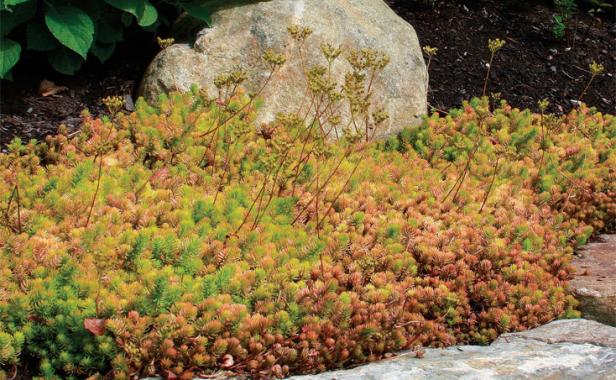
‘Angelina’ sedum
Sedum rupestre ‘Angelina’
Zones: 5 to 9
Size: 4 inches tall and 2 feet wide
Conditions: Full sun; moderately fertile, well-drained soil
Spacing: 1 foot apart for coverage in two seasons
Another drought-tolerant ground cover I’m particularly fond of is ‘Angelina’ sedum. A chartreuse selection of the rugged S. rupestre, this bright and popular plant is hard to miss, even from a distance. When cold weather hits, its needlelike leaves turn orange and red but remain standing through winter. Flat-topped clusters of yellow flowers appear in early summer, but these take a backseat to the colorful foliage itself. ‘Angelina’ sedum thrives in full sun and poor, well-drained soil. The stems root as they grow and even small bits will sprout roots and stems if they find purchase in crevices or cracks.
A willow that creeps

‘Boyd’s Pendulous’ creeping willow
Salix repens ‘Boyd’s Pendulous’
Zones: 5 to 7
Size: 2 feet tall and up to 5 feet wide
Conditions: Full sun; well-drained soil
Spacing: 3 feet apart for coverage in two seasons
A willow may seem like a very un-ground-cover-like choice: Most are trees or shrubs that thrive in damp places. Among this clan, however, there are a few that break the mold. One is ‘Boyd’s Pendulous’ creeping willow, a prostrate willow that tolerates drier soils. It grows as quickly as other willows do, but its stems cascade over the ground rather than reach for the sky. About the time daffodils bloom, masses of fuzzy pussy willow–like catkins swell and turn golden. Shortly thereafter, small narrow leaves clothe the stems. In winter, the dark brown branches tipped with silvery buds flowing over the wall remind me of water trickling over stones.
Need to cover a hot, dry, sandy spot? Look no further

Bearberry
Arctostaphylos uva-ursi and cvs.
Zones: 2 to 6
Size: 4 inches tall and 20 inches wide
Conditions: Full sun to partial shade; sandy, acidic soil
Spacing: 3 feet apart for coverage in two seasons
Dry soil and blazing sun are challenging living conditions for most plants, but bearberry thrives in this combination. This native evergreen shrub is covered in small, leathery, deep green leaves, which turn maroon in cold weather. Early in the growing season, little urn-shaped white-and-pink flowers appear among the leaves. These are followed by large scarlet berries in summer. In years without snow cover, heavy frost may burn the leaves, but they recover in spring. Give bearberry at least six hours of sun a day or else it will grow poorly.
An easy ground cover sure to cast a spell in shade

‘Enchantress’ epimedium
Epimedium ‘Enchantress’
Zones: 5 to 8
Size: 1 foot tall and 1 to 2 feet wide
Conditions: Partial shade; well-drained soil
Spacing: 2 feet apart for coverage in three seasons
I truly appreciate the diversity of epimediums: Within the genus, there are miniatures that are only 3 inches tall as well as “giants” that grow to 3 feet tall when in flower; most epimediums fall somewhere in between. One I particularly like is the hybrid ‘Enchantress’. It doubles in diameter each season, and like most epimediums, this foot-tall semievergreen plant is adaptable once established. It tolerates moderately dry soil and a good bit of shade, though more moisture and a few hours of sun will encourage spread and bloom. ‘Enchantress’ flowers in midspring, covering itself with clouds of 1-inch-wide pink flowers that hang like intricate mobiles on wiry stems.
Divide and prosper
Stem cuttings
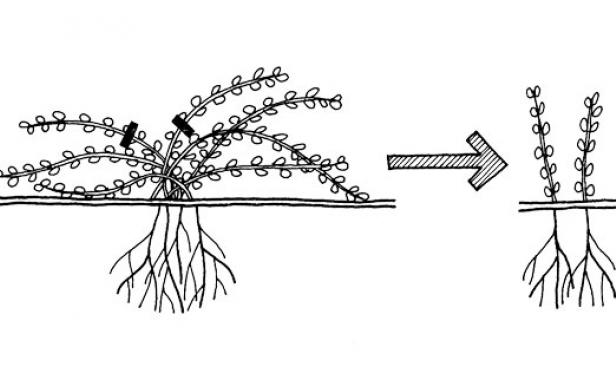
Cut 1-foot-long branch tips from ‘Boyd’s Pendulous’ creeping willow in late winter, and stick them halfway into the ground where you want them to grow. They will root and begin growing in spring.
Divisions
Divide sessile-leaf bellwort, shredded umbrella plant, and ostrich fern in early spring. This should be done before the plants begin growing, but because bellwort is difficult to locate before it emerges, carefully divide it while the new stems are still spear shaped.
Divide ‘Enchantress’ epimedium in late summer. Make sure each piece has at least three sets of leaves. Tease delicate divisions away from clumps of pink running pussy-toes and ‘Angelina’ sedum with a trowel in spring, and replant.
Root cuttings
Sweet fern has shallow, cablelike roots. Dig them out in midspring, cut them into footlong sections, and replant.
Seedlings
Winecups self-sows freely. The seedlings are easy to recognize in spring. Transplant them while they are still small.
Layering

Bury 6-inch-long sections of bearberry stems an inch deep in soil in spring. Roots should form by the following spring, at which point the rooted sections can be snipped off and replanted.
Fine Gardening Recommended Products

Buffalo-Style Gardens: Create a Quirky, One-of-a-Kind Private Garden with Eye-Catching Designs
Fine Gardening receives a commission for items purchased through links on this site, including Amazon Associates and other affiliate advertising programs.

The Crevice Garden: How to make the perfect home for plants from rocky places
Fine Gardening receives a commission for items purchased through links on this site, including Amazon Associates and other affiliate advertising programs.

Corona® Multi-Purpose Metal Mini Garden Shovel
Fine Gardening receives a commission for items purchased through links on this site, including Amazon Associates and other affiliate advertising programs.


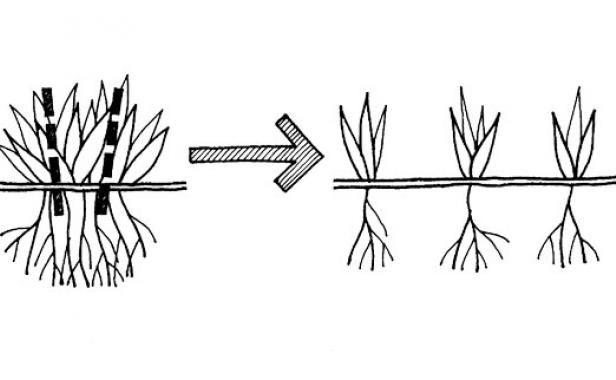

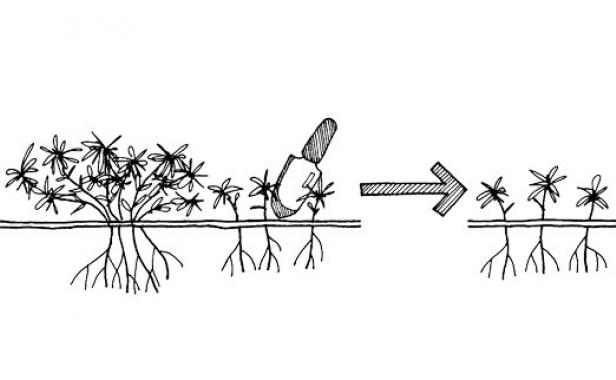




Comments
can sweet fern be grown from seeds?
Your best FG net thing EVER. I learned a lot !!!
Log in or create an account to post a comment.
Sign up Log in